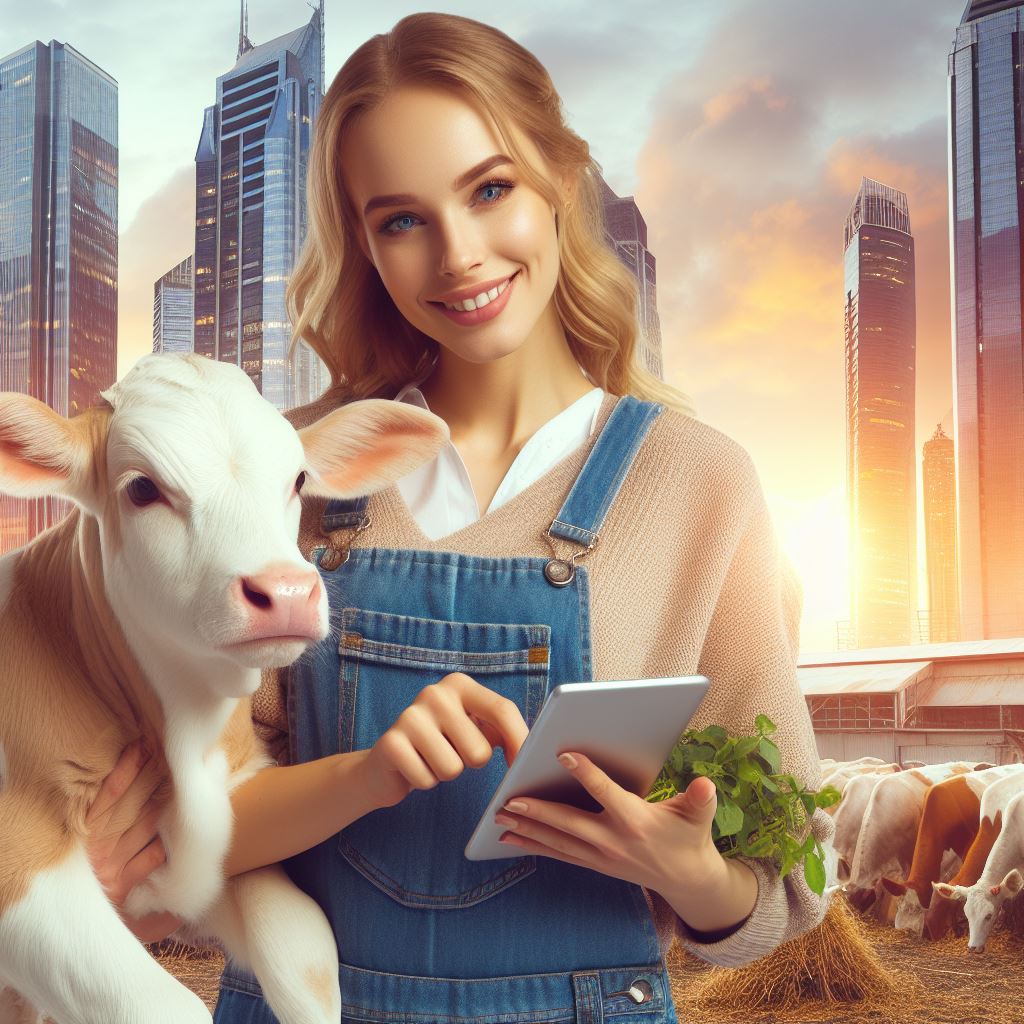Urban Livestock: Raising Chickens & More
Last Updated on February 5, 2024
Introduction
Urban livestock refers to the practice of raising animals such as chickens and other livestock in urban areas.
This concept has gained popularity in recent years due to its numerous benefits and challenges.
One of the major benefits of urban livestock is the ability to produce fresh and nutritious food.
Raising chickens, for example, allows urban dwellers to have access to fresh eggs and meat without relying on commercial sources.
Additionally, urban livestock can help reduce food waste by consuming kitchen scraps and producing organic fertilizer.
Another benefit of urban livestock is the opportunity for individuals to connect with nature and learn important life skills.
Raising animals requires responsibility and dedication, teaching urban dwellers about animal care, resource management, and sustainability.
It can also serve as a source of entertainment and therapeutic value for individuals, especially in highly urbanized areas.
However, raising livestock in urban areas also presents challenges. Limited space can be a major constraint, requiring creative solutions such as vertical farming or rooftop gardens.
Noise and odor concerns from neighbors may arise, requiring proper management systems and respectful communication.
Additionally, ensuring the welfare and well-being of the animals is crucial, as urban environments may expose them to pollution and other hazards.
In short, urban livestock offers a range of benefits, including access to fresh food and opportunities for education and connection with nature.
However, it also poses challenges related to space constraints, noise, and animal welfare.
By addressing these challenges and utilizing innovative methods, urban livestock can play a valuable role in sustainable urban living.
The Benefits of Urban Livestock
Access to fresh, organic food
- Raising chickens and other livestock in urban areas allows residents to have access to fresh, organic food.
- By producing their own eggs, meat, and vegetables, urban dwellers can ensure the quality and safety of their food.
- This promotes a healthier lifestyle and reduces the reliance on processed and potentially harmful foods.
- Urban livestock also allows people to have control over what goes into their food, avoiding harmful chemicals and additives.
Reduction of food miles and environmental impact
- One of the major benefits of urban livestock is the reduction of food miles.
- Food miles refer to the distance that food travels from its source to the consumer.
- By producing food locally, the need for long-distance transportation and refrigeration is minimized, reducing the carbon footprint.
- Urban livestock also helps in decreasing the demand for factory farming, which is a major contributor to greenhouse gas emissions and deforestation.
- By reducing the environmental impact of food production, urban livestock plays a role in combating climate change.
Educational opportunities
- Keeping livestock in urban areas provides excellent educational opportunities for both children and adults.
- It allows people to learn about animal care, nutrition, and sustainable farming practices.
- Children can develop a better understanding of where their food comes from and the importance of responsible farming.
- It also opens up conversations about the ethical treatment of animals and the benefits of organic farming.
- Urban livestock can be integrated into school curricula, promoting hands-on learning and fostering a connection with nature.
Strengthening of community bonds
- Urban livestock brings communities together and strengthens social bonds.
- Neighbors can collaborate and share resources, such as feed and knowledge, to support their livestock projects.
- Community gardens and shared spaces for urban livestock create opportunities for people to interact and bond.
- Livestock keeping can become a communal activity, where individuals from diverse backgrounds work together towards a common goal.
- The shared responsibility and cooperation involved in urban livestock contribute to a sense of belonging and unity within the community.
Promotion of self-sustainability
- Urban livestock promotes self-sustainability by reducing dependence on external food sources.
- By producing their own food, urban residents become less vulnerable to disruptions in the food supply chain.
- It encourages individuals and communities to take control of their own well-being and resilience.
- Engaging in urban livestock fosters a sense of empowerment and self-reliance.
- Additionally, surplus produce from urban livestock can be shared or sold within the community, stimulating local economies.
In fact, urban livestock offers numerous benefits, including access to fresh, organic food, reduction of food miles and environmental impact, educational opportunities, strengthening of community bonds, and promotion of self-sustainability.
Embracing urban livestock not only enhances individual well-being but also contributes to a more sustainable and connected urban environment.
Read: Balcony Farms: Grow Food in Small Spaces
Popular Types of Urban Livestock
Raising chickens
Advantages of backyard chickens
Raising chickens in urban areas has become increasingly popular due to its numerous advantages.
Not only do backyard chickens provide a constant supply of fresh eggs for their owners, but they also contribute to a sense of self-sufficiency and sustainability.
Additionally, raising chickens can be a unique educational experience for children, teaching them about responsibility and the cycle of life.
Common misconceptions and debunking them
However, there are several common misconceptions about raising chickens in urban areas that need to be debunked.
Many people believe that raising chickens requires a large amount of space, emits strong odors, and attracts pests.
In reality, backyard chickens can be kept in compact coops and require minimal space.
Proper coop maintenance and cleanliness help eliminate any potential unpleasant odors.
By following basic biosecurity measures, such as securely enclosing the coop and regularly cleaning the area, the risk of attracting pests can be greatly reduced.
Essential considerations before getting chickens
Before embarking on the journey of raising chickens, there are a few essential considerations to keep in mind.
First, it is important to check local regulations regarding urban livestock.
Some cities may have restrictions on keeping chickens, such as limits on the number of birds or required permits.
Additionally, proper housing is crucial for the well-being of the chickens. A well-built coop with adequate ventilation, insulation, and nesting boxes is necessary to provide a safe and comfortable environment for the birds.
Finally, ensuring a sustainable source of feed and water is essential. Researching local feed suppliers and planning for regular food and water availability is vital for the chickens’ health and productivity.
Potential challenges and how to overcome them
While raising chickens in urban areas can be rewarding, it is not without its challenges.
Predators, such as raccoons, foxes, or neighborhood cats, pose a threat to backyard chickens.
Installing secure fencing around the coop and using predator-deterrent mechanisms, such as motion-sensor lights or alarms, can help mitigate these risks.
Disease prevention is another crucial aspect to consider. Regular vaccination, proper sanitation, and quarantine protocols can help safeguard the chickens’ health.
Additionally, noise concerns may arise, especially in densely populated urban areas.
Communicating with neighbors about the benefits of raising chickens and addressing any concerns they may have can help maintain a harmonious community.
Other urban livestock options
Apart from chickens, there are other urban livestock options that can be considered.
Beekeeping, for instance, not only provides delicious honey but also contributes to pollination, benefiting urban gardens and increasing biodiversity.
Raising rabbits offers a sustainable source of meat, fur, and organic fertilizer, with the added advantage of requiring minimal space.
Goats, known for their weed control abilities, milk production, and companionship, can thrive in urban environments with proper care.
Lastly, aquaponics, a combination of fish farming and crop cultivation, creates a symbiotic system where fish waste fertilizes the plants, and the plants purify the water for the fish.
In essence, urban livestock options such as chickens, bees, rabbits, goats, and aquaponics offer numerous benefits to city dwellers.
By embracing these opportunities, individuals can engage in sustainable food production, reconnect with nature, and foster self-sufficiency within their urban communities.
Read: Sustainable Fertilizers: A Carbon Fix

Getting Started with Urban Livestock
Legal considerations and local regulations
Before diving into urban livestock, it’s crucial to familiarize yourself with the legal considerations and local regulations in your area.
Different municipalities have varying laws and requirements when it comes to raising livestock in urban environments.
Research and understand zoning regulations, restrictions, and permits necessary for keeping livestock in your backyard.
Some cities may restrict certain animals or have specific guidelines for coop construction and maintenance.
Contact local government agencies, such as the zoning department or animal control, to gather information on the regulations you need to adhere to.
It’s important to comply with these regulations to avoid any legal issues or conflicts with your neighbors.
Choosing the right livestock for your urban setting
Once you’ve familiarized yourself with the legal aspects, it’s time to select the right livestock for your urban setting.
Consider the space, climate, and your personal preferences before making a decision.
Chickens are a popular choice for urban livestock due to their small size and egg-laying capabilities. They require minimal space and can be easily managed.
However, if you have limited space, consider bantam or miniature breeds.
Other options to consider include rabbits, quails, or ducks, depending on the regulations and your objectives.
Research the specific needs and care requirements of different species to make an informed decision.
Designing and building appropriate housing and coops
Once you have chosen the livestock, it’s important to design and build suitable housing and coops for them.
A well-designed coop provides shelter, security, and comfort for your animals.
Consider the size and layout of your urban space when designing the housing. It should be built to prevent escapes and protect the animals from predators.
Adequate ventilation, roosting areas, and nesting boxes are essential for the health and productivity of your livestock.
Research and follow recommended guidelines for coop construction, including materials, insulation, and appropriate flooring.
Ensure there is enough space for each animal, allowing them to move freely and engage in natural behaviors.
Sourcing and acquiring livestock
The next step is sourcing and acquiring your chosen livestock. Engage with reputable sources, including local breeders, hatcheries, or animal shelters.
Visit local farmers’ markets, agricultural fairs, or livestock shows to network with experienced breeders and gather valuable information.
This will help you choose healthy and well-suited animals for your urban environment.
Ensure the animals you acquire are vaccinated, disease-free, and conform to any legal requirements.
It’s important to prioritize the welfare of the animals and source them from ethical and responsible suppliers.
Feeding and caring for urban livestock
Feeding and caring for urban livestock requires consistent attention and care. Ensure your animals have access to a balanced and nutritious diet.
Research the dietary needs of your chosen livestock and provide them with appropriate feed, fresh water, and supplements if necessary.
Consult with local veterinarians or agricultural extension offices for specific nutritional recommendations.
Maintain a clean and hygienic environment by regularly cleaning and disinfecting the coops. Regularly monitor their health, and promptly address any signs of illness or distress.
Establish a good relationship with a veterinarian specializing in livestock to ensure their well-being.
Remember to observe noise and odor regulations to maintain harmony with your neighbors.
Being a responsible urban livestock owner includes proper waste management and regular maintenance to minimize any potential nuisances.
By considering legal aspects, choosing suitable livestock, designing appropriate housing, sourcing responsibly, and providing proper care, you can successfully embark on the rewarding journey of raising urban livestock.
Read: Permaculture Zones: Effective Planning
Overcoming Challenges
Noise concerns and managing sound pollution
- Noise from urban livestock can be a concern, but proper management and coop design can minimize it.
- Constructing insulated walls and using soundproof materials can significantly reduce noise disturbances for neighbors.
- Coops should be located away from bedroom windows and sound barriers like trees or fences can help block noise.
- Regular maintenance of coop doors and hinges can prevent loud noises and ensure a quiet environment for neighbors.
- Engage in open communication with neighbors, explaining your intentions and addressing any concerns they may have.
Pest control and disease prevention
- Implement a strict pest control plan by regularly cleaning coops, using rodent-proof feeders, and sealing any entry points.
- Practice good biosecurity measures such as disinfecting shoes and equipment to prevent the spread of diseases.
- Properly dispose of dead animals to avoid attracting pests and prevent disease transmission.
- Regularly inspect and maintain the coop’s structure to prevent infestations and ensure the health of your livestock.
- Consult with a veterinarian to establish a vaccination schedule and obtain guidance on disease prevention.
Odor control and managing waste
- Choose appropriate bedding materials that allow for proper absorption and decomposition of waste.
- Regularly clean and maintain the coop and surrounding areas to minimize odors.
- Composting manure and waste can help manage odor while providing nutrient-rich compost for your garden.
- Install proper ventilation systems to ensure good air circulation and minimize ammonia buildup, which causes odors.
- Communicate with neighbors and educate them about proper waste management practices to foster understanding.
Ensuring the safety of livestock and protecting them from predators
- Construct sturdy and predator-proof enclosures by using hardware cloth, burying fencing underground, and securing openings.
- Utilize motion-activated lights or alarms to deter predators from approaching the livestock areas.
- Employ guardian animals like dogs or even llamas to ward off potential predators.
- Regularly inspect and secure coop doors, windows, and other vulnerable points to prevent unauthorized entry.
- Install surveillance cameras to monitor the livestock area and deter predators.
Dealing with potential conflicts with neighbors or local authorities
- Be a good neighbor by maintaining clean and well-managed facilities, addressing any concerns promptly.
- Establish open lines of communication and invite neighbors to visit your setup to address any misconceptions.
- Familiarize yourself with local ordinances and zoning laws to ensure compliance and avoid conflicts with authorities.
- Attend community meetings or join local urban farming organizations to understand and address neighborhood concerns.
- Consider working cooperatively with neighbors on shared issues, such as noise, odor, or waste management, to find mutually beneficial solutions.
By acknowledging and actively addressing these challenges, urban livestock enthusiasts can create a harmonious coexistence with their neighbors and local authorities.
With responsible practices, proactive communication, and a commitment to mitigating potential issues, raising chickens and other animals in urban settings becomes an enriching experience for both the livestock keepers and their communities.
Read: Water Wise: Urban Farming Irrigation Tips
Conclusion
Urban livestock provides numerous benefits to individuals and communities alike.
By raising chickens or other livestock in urban areas, people can enjoy a variety of advantages such as a sustainable food source, waste reduction, and educational opportunities.
Not only can urban livestock provide a source of fresh eggs, meat, and dairy products, but it also promotes self-sufficiency and sustainability.
By producing their own food, individuals can reduce their reliance on industrial agriculture and ensure the quality and safety of what they consume.
Urban livestock also plays a crucial role in waste reduction. Chickens, for example, are excellent composters and can convert kitchen scraps and yard waste into nutrient-rich fertilizer.
This helps minimize waste going to landfills and contributes to a healthier and greener environment.
Furthermore, raising chickens or other livestock in urban areas can be a valuable educational experience, especially for children.
It teaches them about the importance of animal care, responsibility, and the interconnectedness of the natural world.
I encourage everyone to consider the possibility of raising chickens or other livestock in urban areas.
With careful planning and adherence to local regulations, it’s possible to create a thriving and sustainable urban farm right in your own backyard.
If you have any questions about urban livestock or would like to share your own experiences, I invite you to leave a comment below.
Let’s create a community where we can learn from each other and inspire more people to embrace the benefits of urban livestock.


